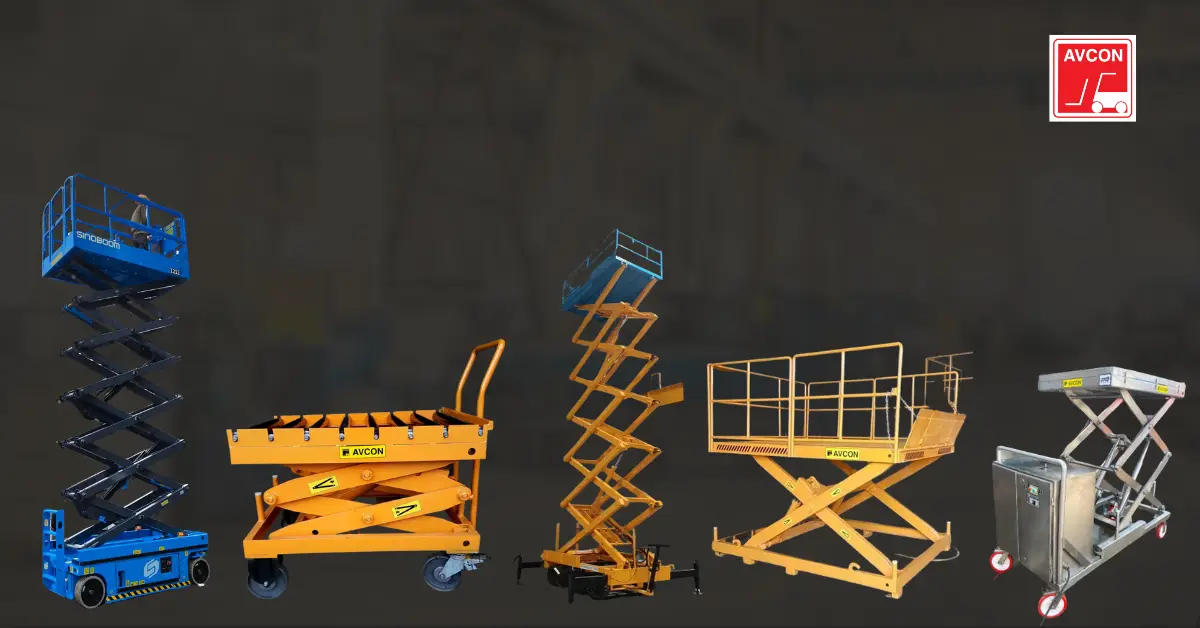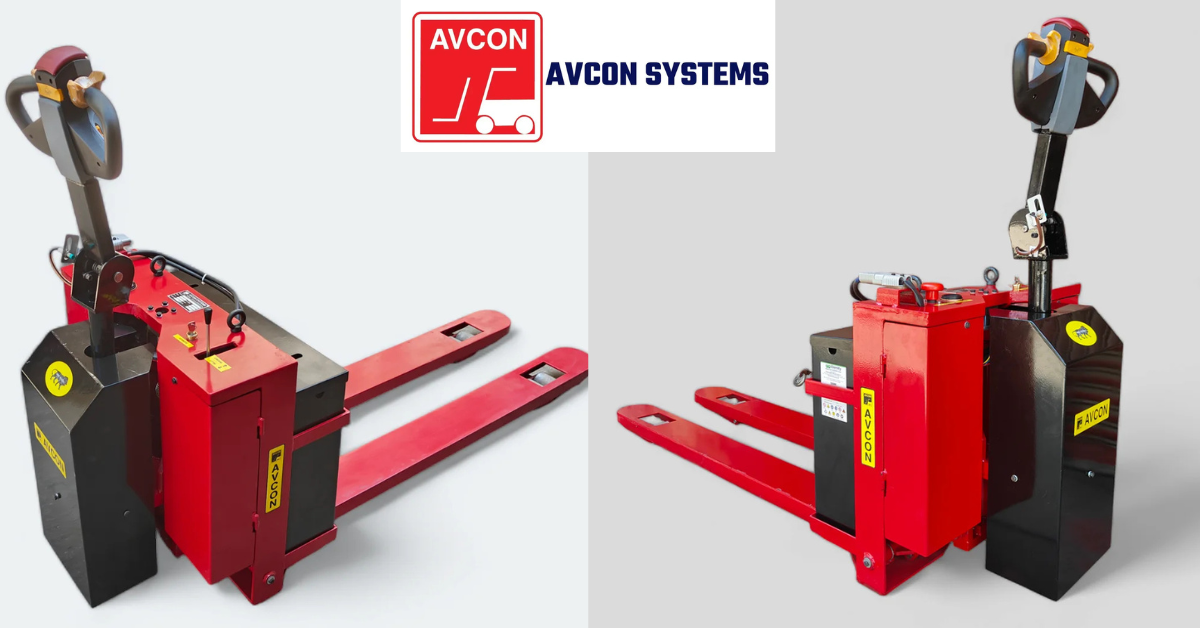Scissor lifts are pivotal in the logistics and warehousing industry, enabling efficient and safe access to elevated spaces. These versatile machines play a critical role in various tasks, including stock picking, facility maintenance, and inventory management. At Avcon Systems, we understand the importance of choosing the right scissor lifts to optimize your operations. In this comprehensive guide, we will explore the five main types of scissor lifts used in logistics and warehousing, their unique features, and their applications.
Introduction to Scissor Lifts
Scissor lifts are essential aerial lift devices equipped with a platform that can be raised vertically. They are widely used in logistics and warehousing for their ability to safely lift workers and materials to various heights. Unlike other aerial lifts, scissor lifts have a crisscrossing (scissor-like) mechanism that allows the platform to move up and down, providing a stable and spacious working area.
The logistics and warehousing industry relies heavily on scissor lifts for several reasons:
- Versatility: They can be used for a variety of tasks, from stacking goods on high shelves to performing maintenance on warehouse infrastructure.
- Safety: Scissor lifts provide a secure platform with guardrails, reducing the risk of falls.
- Efficiency: They enable quick and easy access to elevated areas, enhancing productivity.
Now, let’s delve into the five types of scissor lifts that are commonly used in logistics and warehousing.
Manual Scissor Lifts
Overview
Manual scissor lifts are operated by manual power, typically through a hydraulic hand pump mechanism. They are a cost-effective solution for tasks that do not require frequent lifting or large heights.
Features
- Power Source: Manual hydraulic pump
- Lift Mechanism: Hydraulic system operated by hand pump
- Height Range: Typically up to 10 feet
- Capacity: Up to 2,000 pounds
Applications in Logistics and Warehousing
- Stock Picking: Ideal for picking items from lower shelves, reducing time and effort.
- Loading and Unloading: Assist in loading and unloading lighter goods, improving workflow efficiency.
- Maintenance: Provide a stable platform for facility maintenance tasks, such as replacing lights or inspecting lower warehouse structures.
Advantages
- Cost-Effective: More affordable than electric or diesel scissor lifts.
- Ease of Use: Simple operation with minimal training required.
- Low Maintenance: Fewer moving parts and no engine means less maintenance.
Limitations
- Manual Effort: Requires physical effort to operate.
- Height Limitations: Limited to lower heights compared to powered scissor lifts.
Mobile Semi Electric Scissor Lifts
Overview
Mobile semi-electric scissor lifts combine manual movement with electric lifting mechanisms, providing a balance between manual and fully powered scissor lifts. They are versatile and suitable for various indoor tasks.
Features
- Power Source: Electric motor for lifting, manual for mobility
- Lift Mechanism: Electric hydraulic system
- Height Range: Up to 20 feet
- Capacity: Up to 1,500 pounds
Applications in Logistics and Warehousing
- Indoor Stock Management: Perfect for indoor stock management, allowing workers to reach higher shelves safely.
- Inventory Audits: Used during inventory audits to access high storage areas and ensure accurate counts.
- Facility Maintenance: Provide a stable platform for indoor maintenance tasks without the noise and emissions of diesel scissor lifts.
Advantages
- Quiet Operation: Ideal for indoor environments.
- Efficient Lifting: The Electric lift mechanism reduces manual effort.
- Compact Design: Fits into narrow aisles and small spaces.
Limitations
- Manual Mobility: Requires manual effort to move the lift.
- Power Source: Requires access to electrical power or charging stations.
Pit-Mounted Scissor Lifts
Overview
Pit-mounted scissor lifts are installed in a pit, allowing the platform to be flush with the ground when in the lowered position. They are ideal for loading and unloading heavy goods at a fixed location.
Features
- Power Source: Electric or hydraulic system
- Lift Mechanism: Hydraulic or electric drive system
- Height Range: Varies by model, typically up to 50 feet
- Capacity: Up to 10,000 pounds
Applications in Logistics and Warehousing
- Loading Docks: Ideal for loading and unloading goods from trucks at loading docks.
- Material Handling: Assist in handling heavy materials and equipment.
- Production Lines: Used in production lines to lift and position heavy components.
Advantages
- High Capacity: Can handle very heavy loads.
- Efficiency: Allows for quick and easy loading and unloading.
- Safety: Flush design reduces tripping hazards.
Limitations
- Fixed Location: Cannot be moved easily.
- Installation: Requires installation of a pit, which can be costly.
Pit-Less Scissor Lifts
Overview
Pit-less scissor lifts do not require a pit for installation, making them more versatile and easier to install in various locations. They are suitable for both indoor and outdoor use.
Features
- Power Source: Electric or hydraulic system
- Lift Mechanism: Hydraulic or electric drive system
- Height Range: Varies by model, typically up to 40 feet
- Capacity: Up to 8,000 pounds
Applications in Logistics and Warehousing
- Temporary Worksites: Ideal for temporary worksites where installation of a pit is not feasible.
- Maintenance and Repair: Used for maintenance and repair tasks both indoors and outdoors.
- Versatile Material Handling: Suitable for a wide range of material handling tasks.
Advantages
- Flexible Installation: Can be installed without the need for a pit.
- Versatile: Suitable for various environments and applications.
- Cost-Effective: Lower installation costs compared to pit-mounted scissor lifts.
Limitations
- Capacity: Generally, lower lifting capacity compared to pit-mounted scissor lifts.
- Height Limitations: Limited to lower heights compared to other types of lifts.
Self-Propelled Scissor Lifts
Overview
Self-propelled scissor lifts are fully powered, allowing for both movement and lifting without manual effort. They are ideal for larger warehouses and outdoor sites where mobility is crucial.
Features
- Power Source: Electric or diesel engine
- Lift Mechanism: Electric or hydraulic system
- Height Range: Up to 60 feet
- Capacity: Up to 1,500 pounds
Applications in Logistics and Warehousing
- Large Warehouses: Perfect for large warehouses where frequent movement is required.
- Outdoor Storage: Suitable for accessing outdoor storage areas.
- Construction Projects: Used for construction tasks within warehouse premises.
Advantages
- Full Mobility: Can move and lift without manual effort.
- High Capacity: Can lift heavy loads and reach high elevations.
- Efficient: Reduces time and effort for material handling tasks.
Limitations
- Cost: More expensive than manual or semi-electric scissor lifts.
- Maintenance: Requires regular maintenance of the engine and lift system.
Stainless Steel Scissor Lifts
Overview
Stainless steel scissor lifts are designed for environments that require high levels of hygiene and corrosion resistance. They are commonly used in food processing and pharmaceutical industries.
Features
- Power Source: Electric or hydraulic system
- Lift Mechanism: Stainless steel hydraulic or electric drive system
- Height Range: Up to 40 feet
- Capacity: Up to 2,000 pounds
Applications in Logistics and Warehousing
- Clean Environments: Ideal for clean environments such as food storage and pharmaceuticals.
- Indoor Warehousing: Used for indoor warehousing tasks where hygiene is critical.
- Corrosive Environments: Suitable for environments that may cause corrosion to standard scissor lifts.
Advantages
- Hygiene: Easy to clean and maintain.
- Durability: Resistant to corrosion and wear.
- Versatile: Can be used in various environments, including food and pharmaceuticals.
Limitations
- Cost: More expensive than standard scissor lifts due to the use of stainless steel.
- Weight: Heavier than standard scissor lifts, which may affect mobility.
Choosing the Perfect Scissor Lift for Your Needs
Selecting the appropriate scissor lift for your logistics and warehousing operations involves considering several factors:
- Load Capacity: Determine the maximum weight you need to lift. Ensure the scissor lift you choose can handle your heaviest loads to ensure safety and efficiency.
- Lift Height: Consider the maximum height you need to reach. Whether you’re stacking goods on high shelves or performing maintenance, ensure the lift’s height capacity meets your requirements.
- Environment: Identify where the lift will be used. Electric and pneumatic scissor lifts are ideal for indoor use due to their quiet operation and lack of emissions, while diesel and rough terrain scissor lifts are better suited for outdoor tasks.
- Terrain: Assess the terrain of your worksite. If you’re working on uneven or rough surfaces, a rough terrain scissor lift will provide the stability and durability you need.
- Frequency of Use: Evaluate how often you’ll be using the lift. For frequent, heavy-duty use, invest in a robust model with durable components. For occasional use, a lighter, more economical option may be sufficient.
- Maneuverability: Consider the maneuverability of the lift. In tight spaces or crowded warehouses, a compact and easy-to-handle scissor lift will be more practical.
Maintenance and Safety Tips for Scissor Lifts
- Regular Inspections: Conduct regular inspections of your scissor lifts to ensure they are in good working condition. Check for any signs of wear and tear, leaks, or mechanical issues.
- Proper Training: Ensure that all operators are properly trained on how to use scissor lifts safely. Familiarize them with the lift’s controls, safety features, and emergency procedures.
- Load Limits: Never exceed the specified load limits of the scissor lift. Exceeding weight limits can result in accidents and cause harm to the equipment.
- Stable Positioning: Always position the scissor lift on stable, level ground before use. Engage the lift’s stabilizers if available, to prevent tipping.
- Safety Equipment: Equip operators with appropriate safety gear, such as harnesses and helmets. Ensure that guardrails are in place and in good condition.
- Emergency Procedures: Establish and communicate clear emergency procedures for scissor lift operations. Ensure all operators know how to quickly and safely lower the platform in case of an emergency.
Conclusion
Scissor lifts are indispensable tools in the logistics and warehousing industry, offering a safe and efficient way to access elevated areas. By understanding the unique features and applications of manual, mobile semi-electric, pit-mounted, pit-less, self-propelled, and stainless steel scissor lifts, you can choose the right lift to meet your specific needs. At Avcon Systems, we are committed to providing high-quality scissor lifts that enhance your operational efficiency and safety.
To Know More, Visit This Link –
https://avconforklift.com/leading-material-handling-manufacturer/




